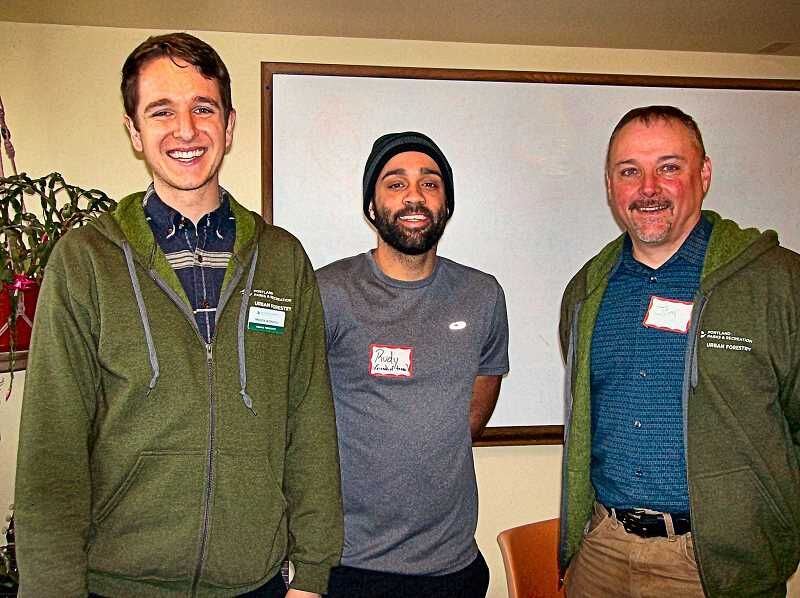Wider species of trees contemplated for Creston-Kenilworth
Published 12:00 am Wednesday, March 29, 2017

- Creston-Kenilworths December Tree Planting Class was presented by, from left: Mason Wordell, PP&R Tree Planting Coordinator; Friends of Trees representative Rudy Roquemore; and Jim Gersbach, from PP&Rs Urban Forestry Center.
A class on selecting diverse tree species for planting in the Creston-Kenilworth neighborhood was held Saturday, December 10, at Kailash Ecovillage — described as a “sustainably focused community located on a two-acre site”, at 4311 S.E. 37 th Avenue, just north of Holgate Boulevard.
Trending
The two-hour forum focused on some 100 tree species, and was hosted by AmeriCorps member Mason Wordell, Tree Planting Coordinator at Portland Parks and Recreation, along with Friends of Trees representative Rudy Roquemore. The class included information on trees offering more variety, shade, moisture retention, and oxygen, as well as helping reduce pollution.
Jim Gersbach from PP&R’s Urban Forestry Center presented nearly-encyclopedic details of replacement trees suggested for the area, without even touching on fruit or nut trees. “In a healthy forest like Portland’s, we strive for diversity, to help minimize potential damage to the tree canopy from disease, insect pests, and adverse weather,” he explained.
Portland lost many tall trees during the infamous Columbus Day Storm of 1962, in which winds reaching 100 mph blew through the metro area; similar winds raked Inner Southeast in the unforecast windstorm of November 13, 1981. Since then, residents have been avoiding replanting of taller tree species, resulting in a selective “dwarfing effect” in the Portland tree canopy. But, argued Gersbach, “The larger the tree, the more the benefits.
“Global trade leads to incoming [invasive] insect pests,” he continued. “Consequently, we’re losing many of our trees to such as Dutch elm disease, emerald ash borers, and Asian longhorn beetles (a risk to maples). Homeowners often prefer to select trees for fruit and flowers; but we’re here to promote plantings of alternate species that can also provide interest, fall color, and variety to the area.”
Wordell explained, “We have tree inventory data for all 96 Portland neighborhoods. Creston-Kenilworth has 92 types of trees, nearly half of which are maples, dogwood, and fruit trees. Only 12% are large-form varieties, which provide more benefits over their lifetime. The Creston-Kenilworth Tree Team plans to protect and enhance the urban forest, for now and for the future.”
A handout listed suggested tree varieties recommended for street-side planting strips, varying according to width of the strip and the distance to overhead power lines. “We discourage species that we have too many of, focusing instead on functional tree species,” Wordell continued. “These types are divided into categories of evergreen and deciduous, broadleaf and conifer, which should enhance overall neighborhood health.”
Gersbach provided detailed information on species’ adaptability to soil and water, their bark and fall leaf colors, and their potential age, root hardiness, shade offered, and appeal to pollinators, birds, and butterflies. Among his species recommendations were strawberry trees, crape myrtles, Amurmaackia, black hawthorn, Chinese pistache, and gumdrop tupelo.
He also praised a hardy hybrid PinkDawn chitalpa coming from Uzbekistan, which has tubular flowers favored by bees and hummingbirds. The European beech tree, Dawykpurple, which originated in Scotland, can live up to 150 years. The Edith Bogue magnolia, an evergreen broadleaf with big white lemon-scented flowers, will hold up in snow and ice, and also provides seeds for birds.
The forum was a tree-lovers treat, including such information as the medicinal qualities of native cascara and Chinese Eucommia ulmoides, planting elms selected for their resistance to Dutch elm disease, and calling attention the beauty of one of the world’s earliest trees, ginkgo.
More information can be secured from Friends of Trees representative Rudy Roquemore — he can be reached by e-mail at: rudyr@friendsoftrees.org — or go online to PP&R’s Urban Forestry website: http://www.portlandoregon.gov/parks/trees





